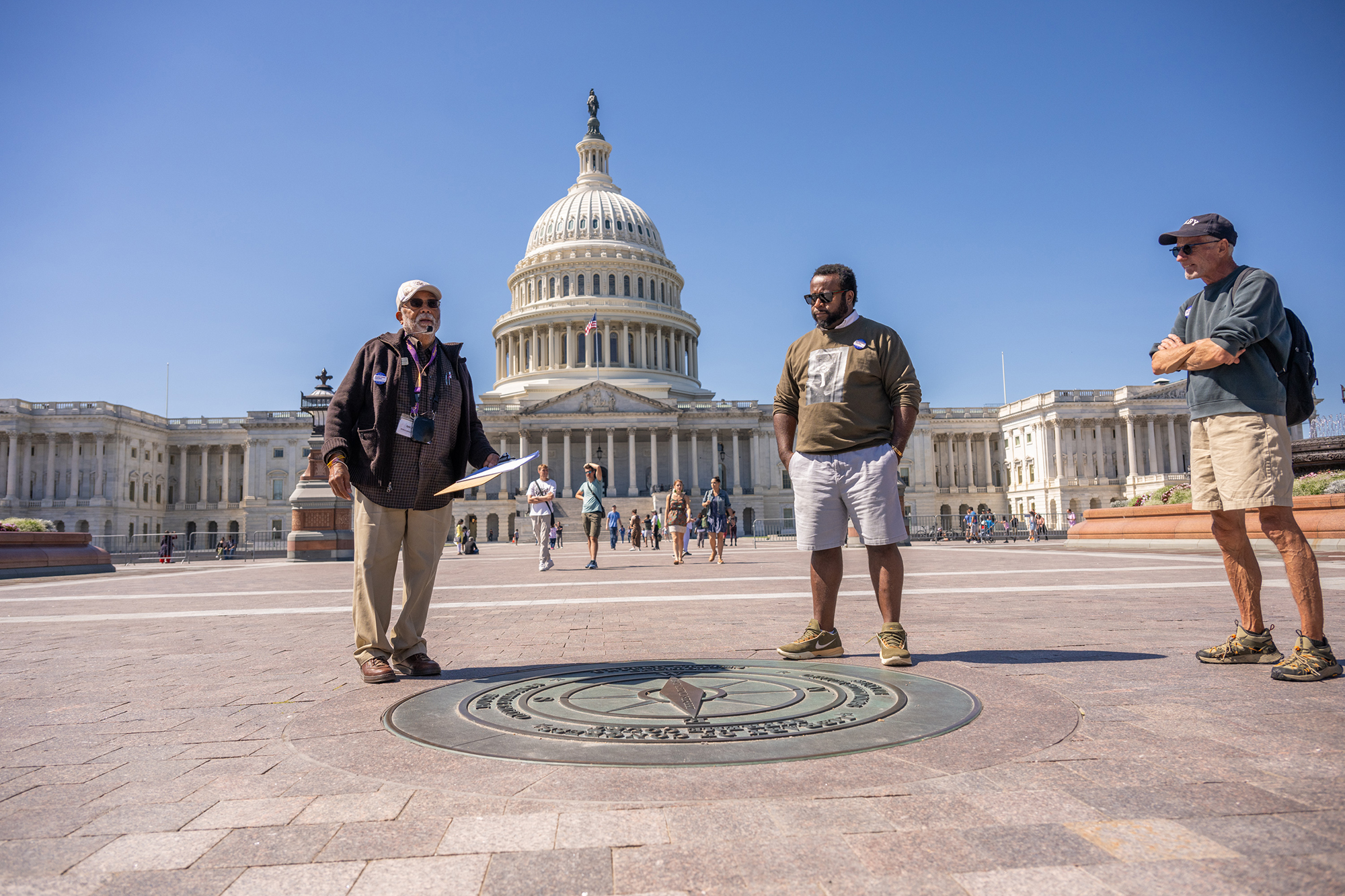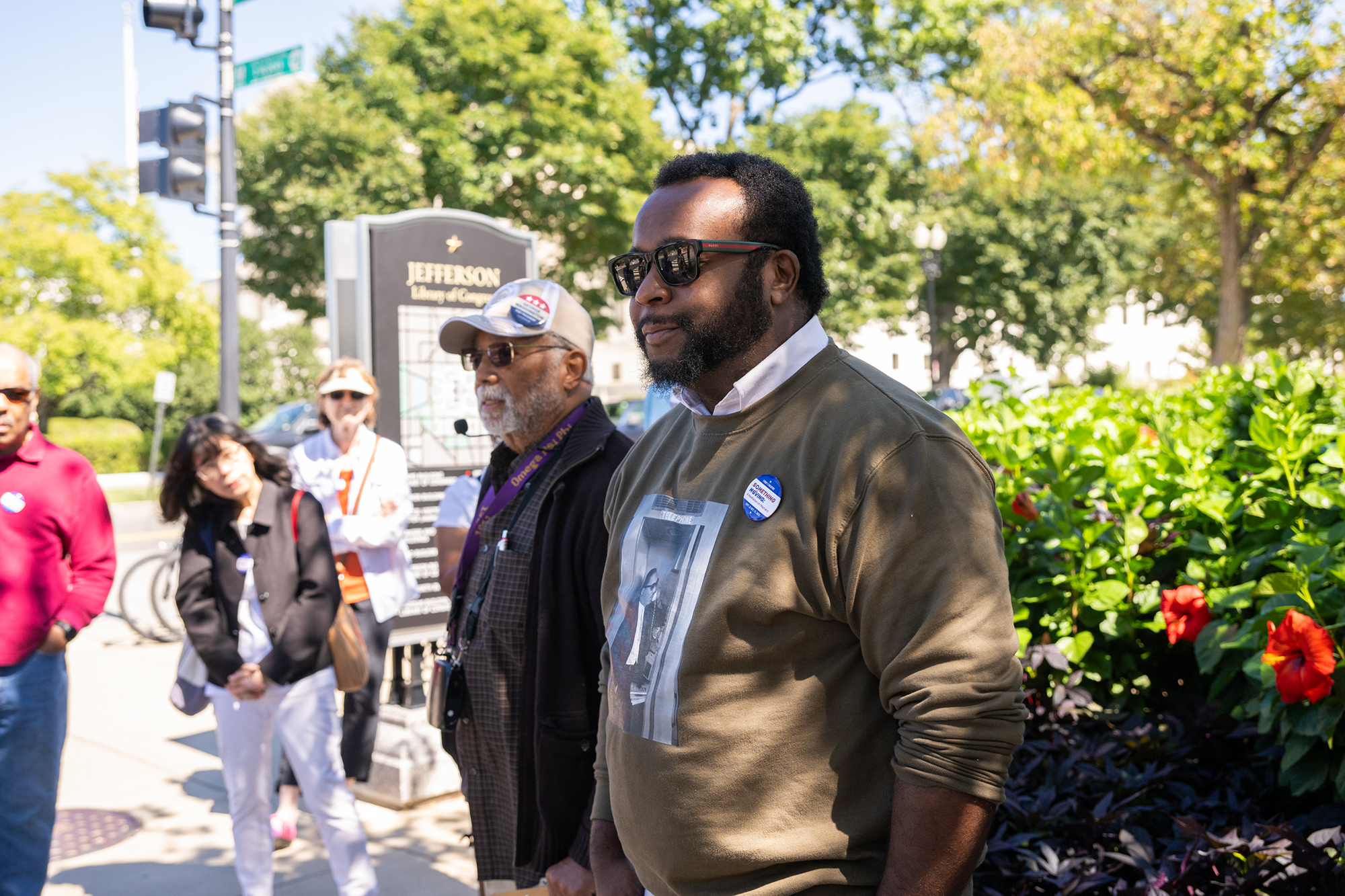
Navigating History and Civics: Anatomy of a Walking Tour
Something Moving: A Meditation on Maynard is a powerful reminder of the lasting importance of public service. Inspired by Pearl Cleage’s work, Ford’s Theatre Education recently hosted a walking tour of Capitol Hill to share stories of service leadership in action during the Civil War.
Who doesn’t love a good, old-fashioned history walking tour? There is nothing quite like learning history by walking in the footsteps of people who used their will and ingenuity to change their community and the world.
Inspired by Ford’s Theatre’s upcoming world premiere of Pearl Cleage’s Something Moving: A Meditation on Maynard, Ford’s Theatre Education hosted a walking tour called Capitol Strides: From the Civil War to Maynard Jackson on September 16, 2023. With the help of Events DC and two great storytellers – licensed D.C. Tour Guide Rohulamin Quander and Ford’s Theatre Board of Trustees member Dr. Giani Clarkson – participants traveled back in time to reflect on civic action and leadership.

The tour came about from a simple idea: get out in the community, share the wonderful history around us and create excitement about Something Moving. This new groundbreaking play examines how Maynard Holbrook Jackson, Jr.’s 1973 election as Mayor of Atlanta inspired and unified his community by making its government accountable to all its citizens. In a rebuke to the horrid legacy of Jim Crow, Jackson paid attention to underserved citizens, and the play’s characters reflect on their own relationship to that work. But as the characters realize, and as our guides reminded us, Jackson did not do this work alone. He understood that he walked in the footsteps of citizen-activists who came before him.
Being Ford’s Theatre, we naturally looked to Washington, D.C.’s rich Civil War history to find those citizen-activists. It did not take long to identify stories of ordinary people taking extraordinary action to move their own communities towards “liberty and justice for all” in ways that inspired future generations, up to and including Maynard Jackson. On this day, we would move our bodies and our minds as we learned from their examples.

We started at the East Plaza of the Capitol. It was a fitting place to establish the historical context of the Civil War. Abraham Lincoln delivered both his inaugural addresses here. Amid the backdrop of an unfinished Capitol building, he spoke about the unfinished work of delivering on America’s lofty ideals. We reflected especially on a landmark rarely noticed by passersby: a simple bronze compass embedded within the East Plaza’s paving stones. It brought to our minds a question all good leaders must ask themselves: what guides our choices? Fame? Legacy? Service to others? Being in touch with our own moral compass is equally vital to citizenship as we evaluate candidates and consider policy within our communities. This metaphor was our lens as we dived into other history on the Hill.

Our next stop was the Jefferson Building of the Library of Congress. During the Civil War, this site was not the monumental center of knowledge and learning it is today. Instead, it was a series of multi-story brick buildings known as Duff Green’s Row that housed many thousands of newly freed refugees from slavery. It was in these buildings that Harriet Jacobs, a woman who had escaped slavery years before, tirelessly worked to both relieve suffering borne of dangerous overcrowding and define freedom for people to whom it had been denied. She helped them find paying work, established schools and wrote to sympathetic organizations in the North for material aid. Jacobs exemplified the power of selfless advocacy for others in need.

Just around the corner stood our next and last stop: the Rayburn House Office Building. Today, this space is a crucible for the democratic process itself, where members of Congress work with each other to write and discuss legislation. It is where “we, the people” have our voices heard. Jackson certainly knew the building well. In 2001, he testified here on the importance of respecting and protecting minority voting rights: “We often hear that the struggle for freedom and the civil rights movement are over,” he said, “[that] those two walking hand in hand are of another era. The struggle for freedom is twofold: 1) get free and 2) stay free. We are currently in the stay free phase of our existence.”[1]

Jackson’s words certainly resonated with history on this exact spot a century and a half before. During the Civil War, the current location of the Rayburn Building was the site of the Israel Bethel Colored Methodist Episcopal Church. This church was a focal point for African American activism at the time, and its pastor, Reverend Henry McNeal Turner, was a leading voice pushing President Lincoln and Congress to recognize African American service in the United States Army and Navy. Lincoln personally appointed Turner as the chaplain of the 1st United States Colored Troops. Other associates of Israel Bethel, such as Reverend Henry Highland Garnet, worked to have Lincoln and Congress to recognize Black voting rights.
Led by great storytellers, this history reminded our audience of the vital role of citizen leadership in creating change both locally and nationally. It was a lesson that Maynard Jackson understood well throughout his public career. Come experience Something Moving, and you will see the same mission unfold on the stage at Ford’s Theatre.
1 “Election Reform.” C-SPAN video, 3:12:41. February 27, 2001. https://www.c-span.org/video/?162821-1/election-reform.
Something Moving: A Meditation on Maynard by Pearl Cleage, directed by Seema Sueko, runs September 22 – October 15, 2023. Get tickets here.

